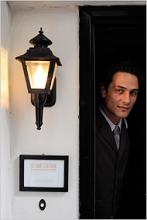Prohibition wasn’t cool. No booze, nasty makeshift distilleries, crackdowns for the faintest smell of beer or whiskey on the breath. But what came out of Prohibition was cool—speakeasies. The password at the door, having to know a friend of a friend to discover the location, the dark glamour. Surely the years since the last day of Prohibition—December 5, 1933—have only heightened the mystery and danger of speakeasies in today’s culture.
Prohibition began in January of 1920. After this year, more than half of American liquor started being produced at home and its taste reflected its unskilled distillers. Because of the nasty taste, older cocktails that relied on the taste of alcohol for its deliciousness started being replaced with available ingredients. Instead, Americans used ingredients that covered up the taste of their sub-par liquor—rye, crème de cacao, ginger and ginger ale.
Nasty tasting alcohol was the least of Prohibition-era peoples’ problems. Obviously, alcohol production was unregulated, so additional ingredients that got into batches of booze went undiscovered. In the holiday season of 1926 alone, 47 New Yorkers died from poisoned alcohol. Jamaica ginger, a medicine with a high alcohol content used as a liquor substitute, made frequent drinkers of the stuff lose the use of their hands and feet.
But the shoddy alcohol didn’t stop the production of speakeasies. And today, most speakeasy reproductions serve cocktails pre-Prohibition—from 1890 to 1910—to stop unnecessary deaths. Today’s speakeasies only emulate the exciting parts of a business trying to stop a police crackdown—dark drapes at the windows, poorly lit booths and a pass code to enter.
Modern speakeasies certainly are a trend. The hidden places of booze and snacks, suspenders and crinoline skirts are springing up around the country like weeds.
Seattle’s Knee High Stocking Co. employs the old technique of pretending that you are some other kind of business, but you really just sell booze. The speakeasy operates out an unassuming building in Capitol Hill with only a tiny sign marking its existence. You have to make a reservation through text message. The windows inside the small establishment are blacked out with pieces of cloth and the bartender makes a mean alcoholic punch every day.
In New York’s Chelsea neighborhood, The Raines Law Room speakeasy makes reference to the 1896 New York State Law that banned the sale of liquor on Sundays except at hotels. The night of the law’s approval, bars put beds and chairs in their rooms and whipped up some food to serve customers—they started calling themselves hotels, too.
The Velvet Tango Room in Cleveland brings speakeasies to the upscale, making sure that each one of their drinks is served in the type of glass in which it was originally served. They have different glasses for each one of their cocktails. They brew their own bitters, sodas and syrups, as well.
Modern speakeasies take the best of a nasty era in American alcohol. Now, you can slip back into the past without worrying about the cops breaking up your party. Best of all, you can drink tasty cocktails that, more often than not, won’t kill you.
